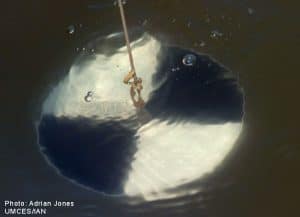
Secchi Disk Submerged Image Courtesy of Adrian Jones, UMCES/IAN
Water clarity is an essential component of pond management. The clarity of the water in your pond or lake influences both the degree of aquatic weed growth and the health of your gamefish population. Maintaining a balance between “too clear” and “too turbid” is often difficult in small, urban ponds.
Unmanaged ponds with excessive underwater weed growth usually have gin-clear water. This is because the plants act as a filter to help remove suspended sediments. The plants also use up nutrients which would otherwise be used in the production of a healthy phytoplankton bloom. A healthy bloom appears as a slight green tint to the water. Under optimum conditions, a bloom should be established early in the growing season. The resulting bloom reduces sunlight penetration to the pond bottom and hinders the growth of noxious aquatic weeds. Ideally, the plankton bloom should result in water clarity of 18-24 inches. The plankton bloom also provides the main building block of the aquatic food chain.
The universal tool for measuring water clarity is called a Secchi disk. A Secchi disk is an 8 inch diameter plate with alternating black and white quadrants. The disk is lowered into the water column until the disk is no longer visible to the naked eye. The resulting reading is the Secchi depth. If the Secchi depth is greater than 24 inches, then a bloom can be stimulated with applications of liquid or granular pond fertilizer. It should be noted that we NEVER recommend adding fertilizer in retention ponds due to their natural nutrient loads from urban watersheds. Too much fertilizer is a recipe for disaster and can lead to noxious algae growth and fish kills.
The addition of pond colorants is another method of reducing water clarity. This is the safest and most cost effective means of countering extra clear water in small, urban ponds. These colorants are made from concentrated, food grade dyes and come in a variety of colors. An effective pond colorant program will require periodic maintenance doses depending on the rate of dilution from rainfall and runoff.
When Secchi depths are less than 18 inches, the normal habits of sight feeding gamefish are compromised. This can result in the decreased growth of fish like largemouth bass and bluegill. Low Secchi depths are usually the result of excess amounts of suspended clay particles or by heavy, single cell algae blooms. Both of these issues can be managed with other pond management practices.
